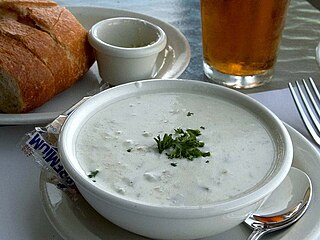
English cuisine encompasses the cooking styles, traditions and recipes associated with England. It has distinctive attributes of its own, but is also very similar to wider British cuisine, partly historically and partly due to the import of ingredients and ideas from the Americas, China, and India during the time of the British Empire and as a result of post-war immigration.

Shepherd's pie, cottage pie, or in its French version hachis Parmentier, is a savoury dish of cooked minced meat topped with mashed potato and baked, formerly also called Sanders or Saunders. The meat used may be either previously cooked or freshly minced. The usual meats are beef or lamb. The two English terms have been used interchangeably since they came into use in the late 18th and early 19th centuries, although some writers insist that a shepherd's pie should contain lamb or mutton, and a cottage pie, beef.

Toad in the hole is a traditional English dish consisting of sausages in Yorkshire pudding batter, usually served with onion gravy and vegetables. Historically, the dish has also been prepared using other meats, such as rump steak and lamb's kidney. In the 21st century, vegetarian and vegan versions have appeared.

Mulligatawny is a soup which originated from South Indian cuisine. The name originates from the Tamil words miḷagu, and taṇṇi ; literally, "pepper-water". It is related to the dish rasam.

Russian cuisine is a collection of the different dishes and cooking traditions of the Russian people as well as a list of culinary products popular in Russia, with most names being known since pre-Soviet times, coming from all kinds of social circles.

Stock, sometimes called bone broth, is a savory cooking liquid that forms the basis of many dishes – particularly soups, stews, and sauces. Making stock involves simmering animal bones, meat, seafood, or vegetables in water or wine, often for an extended period. Mirepoix or other aromatics may be added for more flavor.
Anglo-Indian cuisine is the cuisine that developed during the British Raj in India. The cuisine introduced dishes such as curry, chutney, kedgeree, mulligatawny and pish pash to English palates.

Mock turtle soup is an English soup that was created in the mid-18th century as an imitation of green turtle soup. It often uses brains and organ meats such as calf's head to duplicate the texture and flavour of the original's turtle meat after the green turtles used to make the original dish were hunted nearly to extinction. In the United States, mock turtle soup eventually became more popular than the original dish and is still popular in Cincinnati. The soup is also a traditional dish in the Lower Saxony areas of Germany, where it is considered a specialty of English cuisine.

Cock-a-leekie soup is a Scottish soup dish consisting of leeks and peppered chicken stock, often thickened with rice, or sometimes barley. The original recipe added prunes during cooking, and traditionalists still garnish with a julienne of prunes.
Windsor soup or Brown Windsor soup is a British soup. While commonly associated with the Victorian and Edwardian eras, the practice of calling it 'Brown Windsor' did not emerge until at least the 1920s, and the name was usually associated with low-quality brown soup of uncertain ingredients. Although Windsor soup comprised elegant recipes among famous chefs of the 19th century, the 'Brown Windsor' varieties became an institutional gruel that gained a reputation as indicative of bad English food during the mid-20th century, and a later source of jokes, myths and legends.
Hodge-podge or hotch potch is a soup or stew, usually based on diced mutton or other meat, with green and root vegetables. It is familiar in different versions in Britain and North America and is particularly associated with Scotland.

Fish soup is a food made by combining fish or seafood with vegetables and stock, juice, water, or another liquid. Hot soups are additionally characterized by boiling solid ingredients in liquids in a pot until the flavors are extracted, forming a broth.

Soup is a primarily liquid food, generally served warm or hot, that is made by combining ingredients of meat or vegetables with stock, milk, or water. Hot soups are additionally characterized by boiling solid ingredients in liquids in a pot until the flavors are extracted, forming a broth. Soups are similar to stews, and in some cases there may not be a clear distinction between the two; however, soups generally have more liquid (broth) than stews.

Bavarian cuisine is a style of cooking from Bavaria, Germany. Bavarian cuisine includes many meat and Knödel dishes, and often uses flour. Due to its rural conditions and Alpine climate, primarily crops such as wheat, barley, potatoes, beets, carrots, onion and cabbage do well in Bavaria, being a staple in the German diet.

Game pie is a form of meat pie featuring game. The dish dates from Roman times when the main ingredients were wild birds and animals such as partridge, pheasant, deer, and hare. The pies reached their most elaborate form in Victorian England, with complex recipes and specialized moulds and serving dishes. Modern versions are simpler but savoury combinations of rabbit, venison, pigeon, pheasant, and other commercially available game.

Veal liver and bacon is a dish containing veal liver and bacon.

Modern Cookery for Private Families is an English cookery book by Eliza Acton. It was first published by Longmans in 1845, and was a best-seller, running through 13 editions by 1853, though its sales were later overtaken by Mrs Beeton. On the strength of the book, Delia Smith called Acton "the best writer of recipes in the English language", while Elizabeth David wondered why "this peerless writer" had been eclipsed by such inferior and inexperienced imitators.

Vegetable soup is a common soup prepared using vegetables and leaf vegetables as primary ingredients. It dates to ancient history, and is a mass-produced food product in contemporary times.















